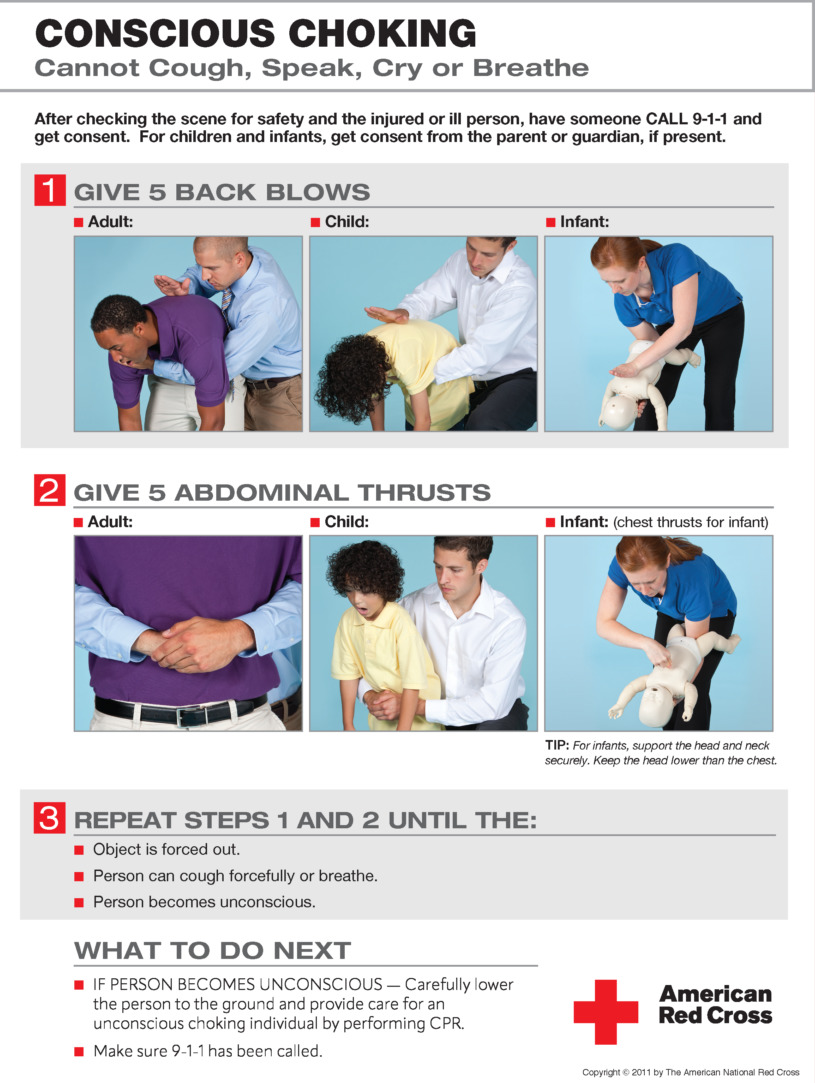
Special to Iredell Free News
Imagine you are sitting at a restaurant and notice the person in the booth behind you is choking. Luckily, someone in the restaurant knows how to save them. Witnessing someone choking is scary for everyone, but it’s even more frightening when it’s your own child.
Choking is one of the leading causes of death in children under the age of 4, but you can take steps to protect your child and learn what to do in the event of a choking emergency.
How to Recognize when Someone is Choking

“Choking is when something like food or an object is caught in the back of the throat. The object blocks the top of the trachea, which causes a person to be unable to breathe properly,” said Dr. Judith Prairie, a physician at Family Care Center of Mooresville.
According to Prairie, signs that a child is choking can include:
• Touching their throat or neck
• Coughing, wheezing, or gagging
• Difficulty breathing
• Making a whistling sound when trying to breath
• Unable to make any sound or cry
• Lips, face, earlobes, or fingernails turning blue
• Loss of consciousness
How to Clear the Airway
First and foremost, if your child is exhibiting any of the signs of choking, it’s important to remain calm and not let your child see you panic.
According to Prairie, you should not put your finger in your child’s mouth to remove the object as your finger could push the object deeper into your child’s throat.
If your child is conscious, but cannot cough, speak, cry, or breathe, tell someone nearby to call 911 and follow the steps listed below from the American Red Cross. These steps are slightly different for babies under the age of 1.
1. Give 5 back blows: Bend the child forward at the waist and give them five back blows (firm hit on the back) between the shoulder blades with the heel of one hand.
*For babies: Hold the baby face down with their head slightly lower than their feet. Support the baby’s jaw and head with your hand. Support their weight with your knee if you are sitting and on your forearm if you are standing.
2. Give 5 abdominal thrusts (formerly known as the Heimlich maneuver): Place a fist with the thumb side against the middle of the child’s abdomen, just above the bellybutton. Cover your fist with the other hand. Give five quick, upward abdominal thrusts, as if trying to lift the child up.
*For babies: Turn your baby over onto their back between your arms and hands. Use two fingers in the center of the chest, lower breastbone, to perform chest thrusts. According to Prairie, make sure your fingers are not off to one side or at the bottom of your baby’s breast bone. Support the head and neck securely, and keep the head lower than the chest.
3. Repeat the previous two steps, alternating between five back blows and five abdominal thrusts, until the object is forced out, the child can cough, speak, cry, or breathe, or if they become unresponsive. If your child becomes unresponsive, call 9-1-1, if not already done, and begin CPR with chest compressions and rescue breaths.
“If your child has trouble breathing but can still talk and has a strong cough, encourage your child to cough until the object comes out. Do not do abdominal thrusts, and watch your child closely to make sure the object comes out and doesn’t shift to fully block the throat,” said Prairie.

Prevention Tips
The thought of your child choking can be scary. Fortunately, there are several steps you can take and foods to avoid to keep your child safe.
“Approximately 60% of non-fatal choking hazards are caused by food items,” said Prairie.
Hard candy, grapes, nuts, raw carrots, apples, marshmallows, popcorn, cheese cubes, gummy fruit snacks, peanut butter, and hot dogs are all common choking hazards for children.
The United States Department of Agriculture (USDA) recommends parents cut round foods, such as grapes, cherries, and cherry tomatoes, into smaller pieces, slicing them in half lengthwise, no larger than half-inch. The USDA also recommends parents cut tube-shape foods, such as baby carrots, string cheese, and hot dogs, into short strips rather than round pieces.
According to Prairie, other common choking hazards include marbles, disc batteries (button batteries), coins, balls, small toys, pen or marker caps, and safety pins.
“Supervision is the single most important factor to prevent choking,” said Prairie.
It’s crucial to keep an eye on your baby during playtime and supervise your children while they eat to make sure they do not eat too fast.
“You can also avoid choking hazards by keeping small objects out of reach, purchasing ageappropriate toys, eating food only at the table, cooking vegetables until they are soft, encouraging adequate chewing, and having a drink available for your child when eating,” she said.
With a little extra attention, you can keep your children safe and protect them from choking.
LEARN MORE
Prairie practices at the Family Care Center of Mooresville, located on the second floor of Iredell Mooresville at 653 Bluefield Road. She treats patients of all ages, infants to seniors. If you would like to schedule an appointment with Dr. Judith Prairie, please call 704-360-6580.
About Iredell Health System
Iredell Health System includes Iredell Memorial Hospital; Iredell Mooresville; Iredell Home Health; Iredell Wound Care & Hyperbaric Center; Community and Corporate Wellness; Occupational Medicine; the Iredell Physician Network and more. Iredell Memorial Hospital is the largest and only nonprofit hospital in Iredell County. The comprehensive healthcare facility has 247 beds; more than 1,700 employees; and has 260 physicians representing various specialties. Centers of excellence include Women’s and Children’s; Cardiovascular; Cancer; Surgical Services and Wellness & Prevention. The Health System’s newest campus, Iredell Mooresville, is home to the area’s only 24-hour urgent care facility, as well as an ambulatory surgery center, imaging center, rehabilitation services, and physician practices. The mission of Iredell Health System is to inspire wellbeing. For a comprehensive list of services and programs, visit www.iredellhealth.org.



